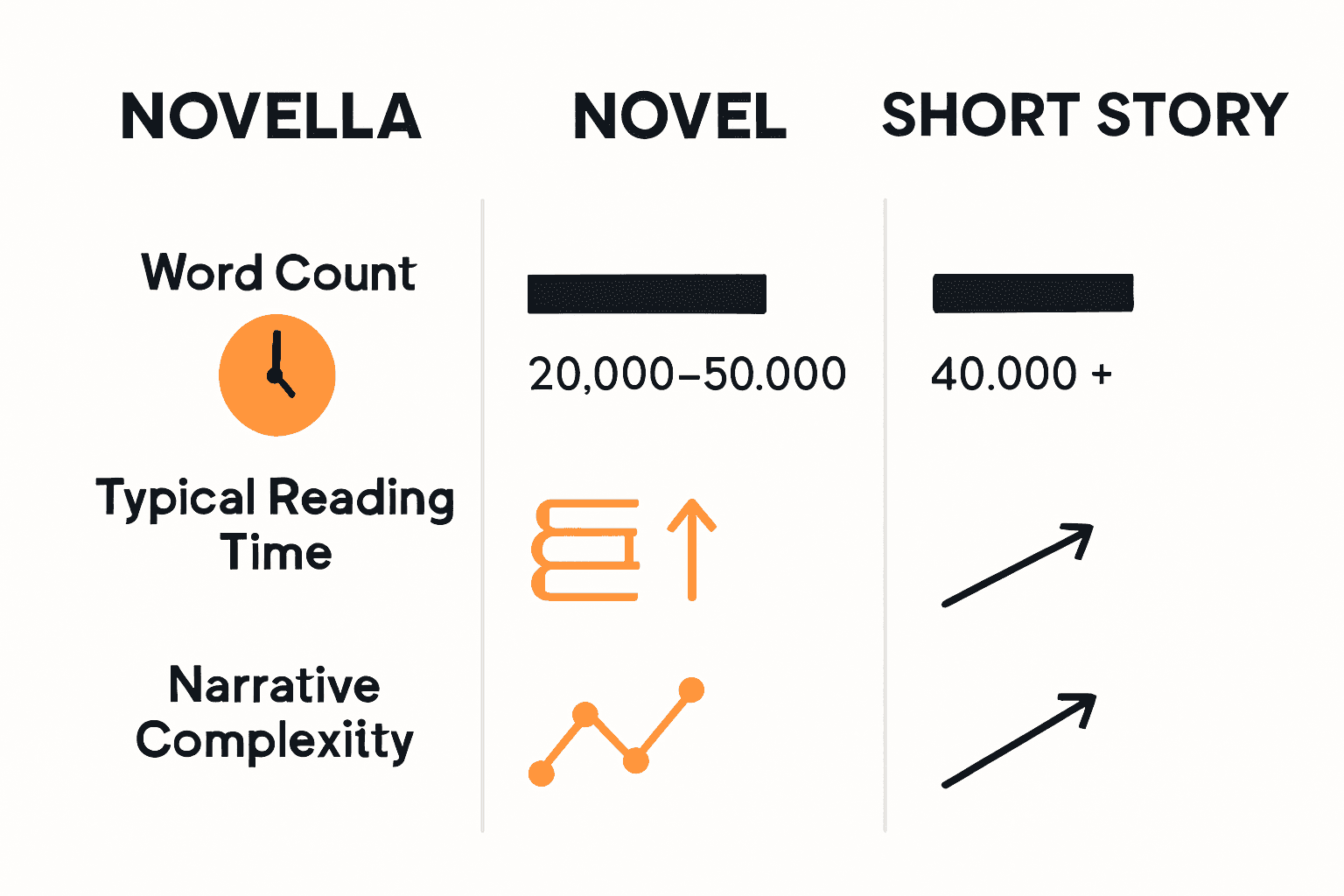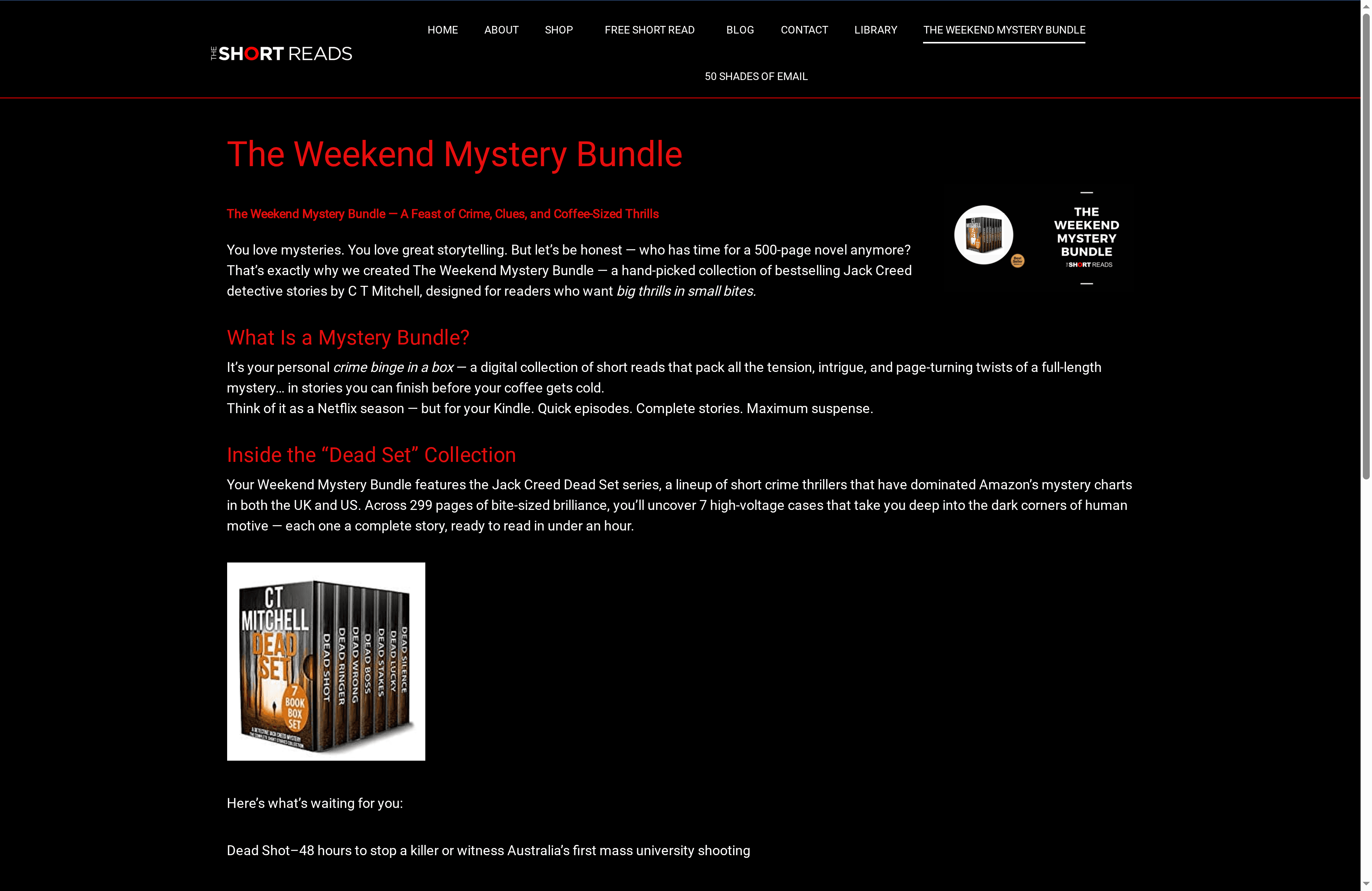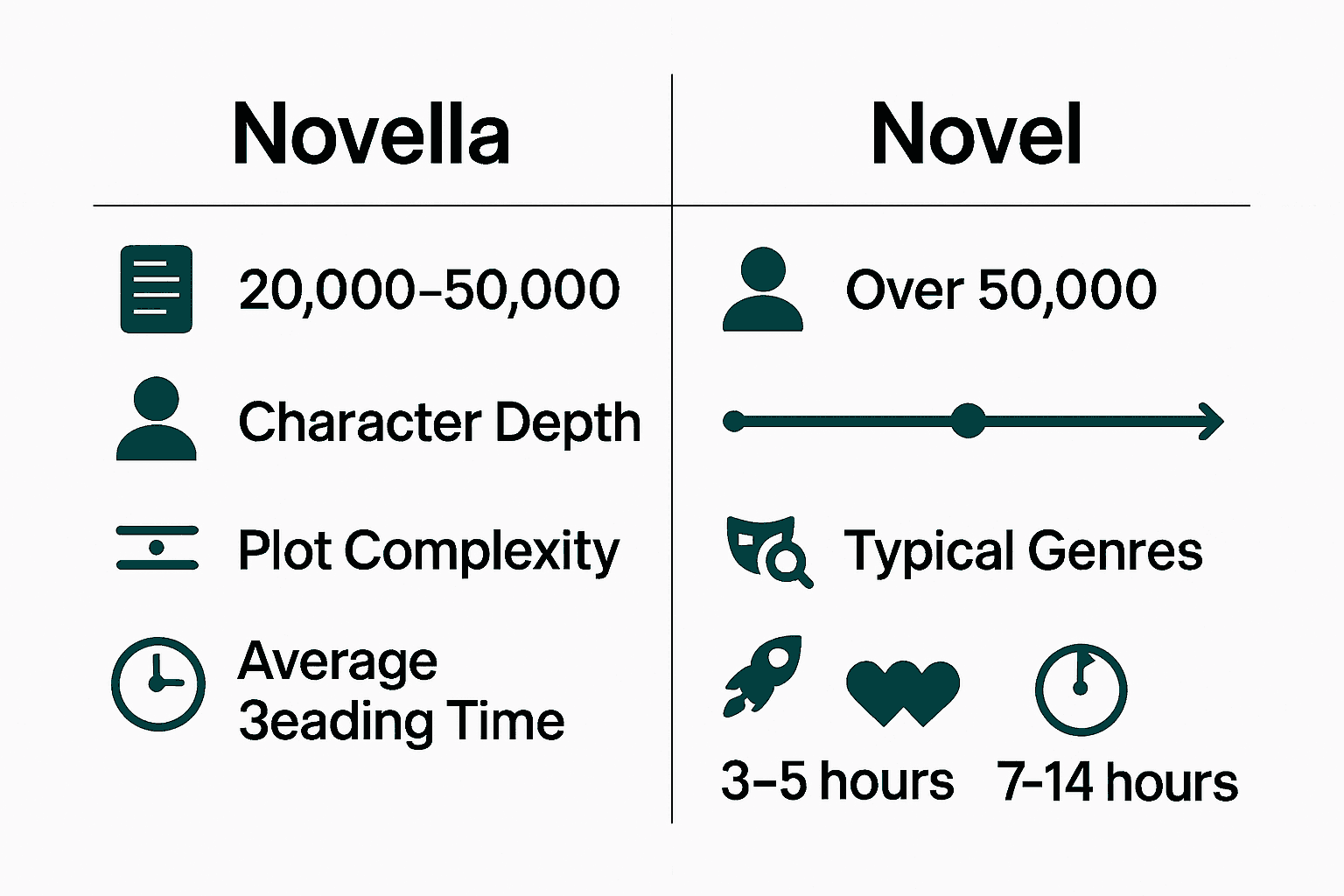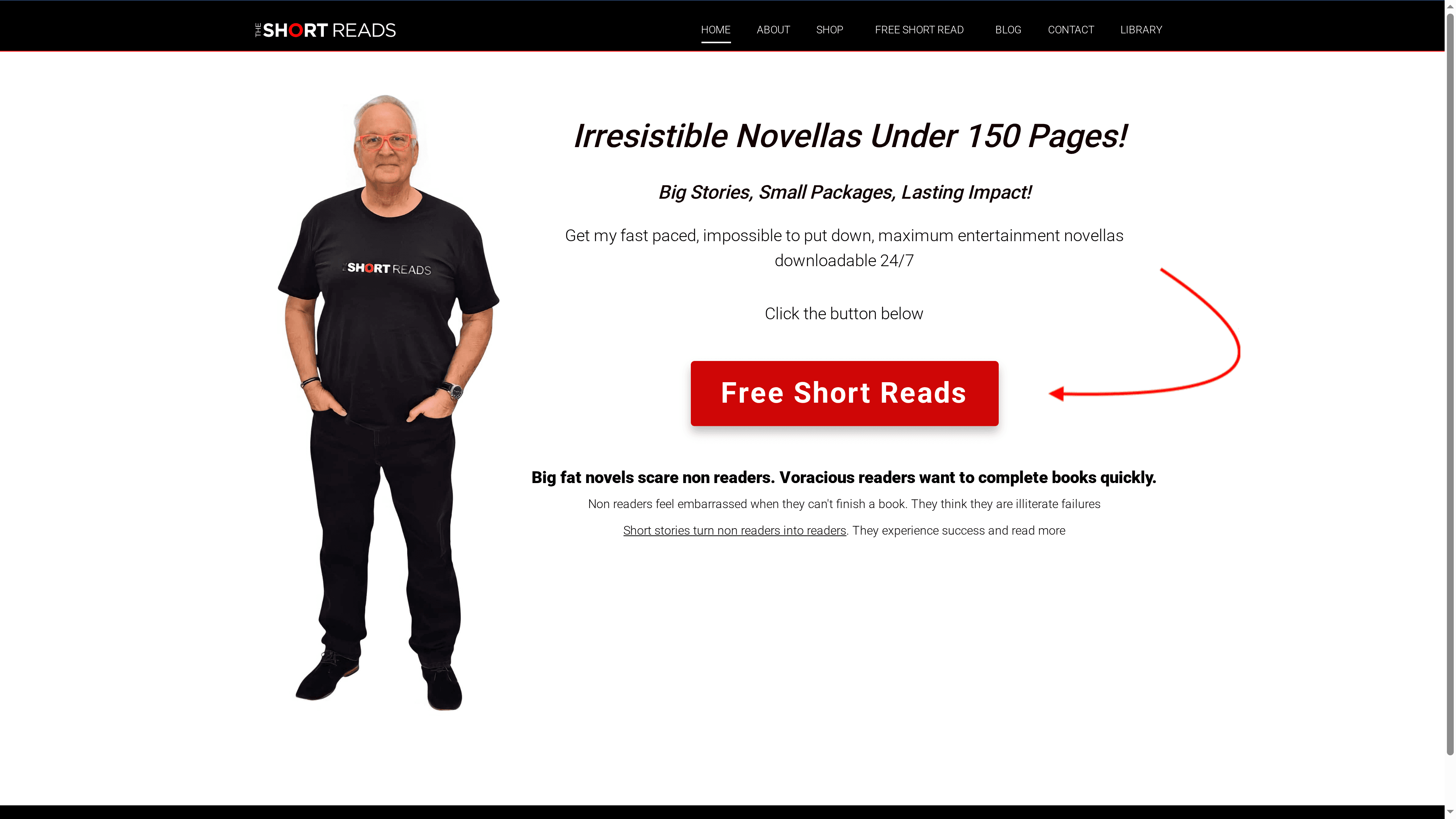Tag Archives for " novellas "
Why Novellas Are Popular: Complete Reader Guide

Nearly every avid reader has discovered the sweet spot between short stories and lengthy novels, where novellas shine. These compact works pack the emotional punch and depth of full novels into a format that rarely exceeds 50,000 words. For time-pressed readers, novellas offer an immersive escape without the marathon commitment, making them more appealing than ever. This guide reveals what sets novellas apart, clears up common misconceptions, and spotlights why their unique structure captures global audiences.
Table of Contents
- Novellas Defined: Core Features And Myths
- Types Of Novellas In Mystery And Thriller
- How Novellas Fit Busy Modern Lifestyles
- Appeal To Diverse And Global Audiences
- Novellas Versus Novels And Short Stories
Key Takeaways
| Point | Details |
|---|---|
| Defining Characteristics | Novellas, distinct from novels and short stories, typically focus on a single conflict, feature condensed character development, and can be read in one sitting. |
| Popularity Growth | The increasing demand for immersive yet quick narratives makes novellas appealing to busy readers seeking convenience without compromising storytelling quality. |
| Genre Versatility | Mystery and thriller novellas encompass various subgenres, each providing unique storytelling experiences while maintaining fast-paced narratives. |
| Cultural Accessibility | Novellas allow for diverse themes and global perspectives, making them accessible to a broad audience through their concise format and universal appeal. |
Novellas Defined: Core Features And Myths
A novella occupies a unique literary space between short stories and full-length novels, offering readers a compact yet immersive narrative experience. According to Wikipedia, the term originates from the Italian word ‘novella’, meaning ‘new’, and represents a prose fiction form with distinct structural characteristics that set it apart from longer and shorter written works.
Novellas are characterized by several core features that distinguish them from traditional novels and short stories. As research from University of Babylon indicates, these narratives typically possess the following attributes:
- Focused Narrative: Concentrates on a single primary conflict or theme
- Condensed Character Development: Fewer characters compared to novels
- Compact Length: Designed to be read in one sitting
- Realistic Tone: Often satirical or grounded in realistic storytelling
- Minimal Chapter Structure: Generally lacks traditional chapter divisions
Contrary to common myths, novellas are not simply ‘shorter novels’ but sophisticated literary forms with their own narrative integrity. They require precise storytelling skills, demanding authors craft complex narratives within limited word counts.
 Writers must strategically develop characters, advance plot, and create meaningful narrative arcs without the expansive canvas of a full novel.
Writers must strategically develop characters, advance plot, and create meaningful narrative arcs without the expansive canvas of a full novel.
The popularity of novellas continues to grow, particularly among busy readers and those seeking immersive storytelling experiences that can be consumed quickly. Short Reads vs Novellas: Everything You Need to Know provides deeper insights into why these compact narratives have captured readers’ imaginations across various genres and reading preferences.
Types Of Novellas In Mystery And Thriller
Mystery and thriller novellas represent a dynamic and captivating literary genre that delivers intense storytelling within a compact narrative framework. According to MWEditing, these narratives are characterized by fast-paced plots, intriguing mysteries, and suspenseful twists that keep readers engaged through unexpected revelations and gripping storylines.
The mystery and thriller novella landscape encompasses several distinctive subgenres, each offering unique storytelling approaches:
- Hard-Boiled Mysteries: Urban settings with complex moral landscapes
- Cozy Mysteries: Lighthearted narratives with less graphic violence
- Psychological Thrillers: Deep explorations of character mental states
- Political Thriller Novellas: Intrigue centered around governmental or institutional conflicts
- Detective Short Reads: Compact investigations with focused narrative arcs
As MasterClass explains, each subgenre brings its own distinctive elements to the novella format. Hard-boiled mysteries often feature morally ambiguous urban landscapes, while cozy mysteries provide gentler, more lighthearted narrative experiences that appeal to readers seeking less intense storytelling.
For readers seeking immersive yet quick reading experiences, thriller novellas offer the perfect balance of suspense and concise storytelling. These compact narratives allow readers to experience complete, intricate stories without the time commitment of full-length novels, making them ideal for busy mystery enthusiasts who crave compelling narratives in bite-sized formats.
How Novellas Fit Busy Modern Lifestyles
In today’s fast-paced world, reading time is a precious commodity, and novellas have emerged as the perfect literary solution for time-strapped book lovers. According to MWEditing, these compact narratives cater specifically to readers with limited time by offering concise yet complete stories that can be consumed in a single sitting.
The unique advantages of novellas for busy individuals include:
- Quick Consumption: Complete stories readable in one sitting
- Minimal Time Investment: Shorter than traditional novels
- High-Intensity Narratives: Concentrated plot and character development
- Flexible Reading: Perfect for commutes, lunch breaks, or short leisure moments
- Storytelling Efficiency: Maximum narrative impact with minimum time commitment
Research from University of Babylon confirms that novellas are strategically designed to provide full narrative experiences without demanding extensive time investments. This makes them particularly attractive to professionals, students, and anyone struggling to balance reading with demanding schedules.
For those seeking practical reading strategies that align with modern lifestyle constraints, short reads benefits guide offers additional insights into maximizing literary enjoyment within limited timeframes. Novellas represent more than just shorter books – they’re a sophisticated reading approach tailored for contemporary readers who refuse to compromise on storytelling quality despite time limitations.
Appeal To Diverse And Global Audiences
Novellas represent a powerful literary form that transcends cultural boundaries, offering a unique storytelling experience that resonates with readers across different backgrounds and languages. According to MWEditing, the concise format allows authors to explore diverse themes and settings, making these compact narratives remarkably accessible to a global readership.
The universal appeal of novellas is rooted in several key characteristics that make them attractive to diverse audiences:
- Linguistic Accessibility: Easier translation due to shorter length
- Cultural Flexibility: Adaptable narratives that cross geographical boundaries
- Thematic Universality: Exploration of fundamental human experiences
- Economic Reading: Affordable and less time-consuming for international readers
- Genre Diversity: Wide range of storytelling styles and perspectives
Research from University of Babylon highlights the novella’s historical influence across European literary traditions, demonstrating its remarkable ability to create realistic narratives that resonate with diverse audiences. The compact format allows for nuanced storytelling that can bridge cultural differences while maintaining narrative intensity.
For readers seeking global perspectives, mystery novellas offer an exceptional window into different cultural experiences, providing rich storytelling without the significant time investment of full-length novels. This unique literary form continues to break down cultural barriers, offering readers a sophisticated yet accessible approach to understanding diverse human experiences.
Novellas Versus Novels And Short Stories
The literary landscape is rich with diverse narrative forms, each offering unique storytelling experiences. According to Wikipedia, novellas occupy a distinctive middle ground, characterized by a length that falls between short stories and full-length novels, creating a compelling format that captures readers’ imagination with remarkable precision.
Key differences between novellas, novels, and short stories include:
- Length: Novellas range from 30,000 to 50,000 words, compared to novels (over 50,000 words) and short stories (under 7,500 words)
- Narrative Complexity: More developed than short stories, less intricate than novels
- Character Development: Focused character arcs with limited but deep exploration
- Plot Structure: Single primary conflict versus multiple subplots in novels
- Reading Time: Typically completed in one sitting
Research from University of Babylon emphasizes that while novels generally extend beyond 200 pages with complex narrative structures, novellas offer a more concentrated storytelling experience. They provide readers with a complete narrative journey without the extensive time commitment required by full-length novels.

For readers seeking a deeper understanding of these literary distinctions, Novellas vs. Novels: Complete Guide to Key Differences offers comprehensive insights into the nuanced world of narrative formats. Novellas ultimately represent a sophisticated middle ground, delivering rich storytelling with exceptional narrative efficiency.
Discover Perfect Novellas That Fit Your Busy Life and Mystery Cravings
Finding time to enjoy a captivating story can be tough when life moves fast. This article highlights how novellas meet the challenge by offering quick yet immersive storytelling with focused narratives and intense plots. Whether you are drawn to cozy mysteries, psychological thrillers, or political intrigue, the compact format of novellas lets you experience rich characters and suspenseful twists without a huge time commitment.
Enjoy the emotional excitement of a complete story in one sitting by exploring our Weekend Mystery Bundle.

Dive into a collection curated for readers who value both quality and convenience. From cozy mystery short reads to murder mystery novellas, our selections bring you intense plotlines and carefully crafted characters ready to thrill and entertain. Start your novella journey now at The Short Reads and experience the perfect balance of suspense and brevity tailored for your lifestyle.
Frequently Asked Questions
What defines a novella compared to a novel and a short story?
A novella typically ranges from 30,000 to 50,000 words, offering a more developed narrative than a short story (under 7,500 words) but less complexity than a full-length novel (over 50,000 words). It focuses on a single conflict and allows for concentrated character development within a compact format.
Why are novellas appealing to busy readers?
Novellas are designed for quick reading, allowing busy individuals to complete a story in one sitting. Their concise narratives provide high-intensity storytelling with minimal time investment, making them ideal for readers looking to fit literature into hectic schedules.
What are the main themes explored in mystery and thriller novellas?
Mystery and thriller novellas often explore themes such as crime, morality, psychological tension, and political intrigue. They captivate readers with fast-paced plots, unexpected twists, and a focus on single primary conflicts that draw readers into the narrative.
How do novellas resonate with a global audience?
Novellas are linguistically and culturally accessible due to their shorter length, making them easier to translate and adapt across different cultural contexts. Their universal themes, such as fundamental human experiences, appeal to diverse audiences, allowing readers worldwide to engage with a variety of storytelling perspectives.
Recommended
- The Essential Guide to the Role of Novellas in Fiction – TheShortReads.com
- Novellas vs. Novels: Complete Guide to Key Differences – TheShortReads.com
- Short Reads vs Novellas: Everything You Need to Know – TheShortReads.com
Novellas vs. Novels: Complete Guide to Key Differences

A novella offers a unique middle ground in fiction, packing a punch with its concise storytelling. For many readers and writers, knowing whether a story is best told as a novella or a novel can shape the entire reading experience. With novels typically exceeding 50,000 words and novellas ranging from 20,000 to 40,000 words, these two forms provide distinct ways to explore characters and worlds. Understanding their differences helps you choose the right path for your next literary adventure.
Table of Contents
- Defining Novellas And Novels: Core Differences
- Length, Structure, And Narrative Scope
- Genre Trends In Novellas And Novels
- Audience Appeal And Reader Experiences
- Choosing Between Novellas And Novels
Key Takeaways
| Point | Details |
|---|---|
| Length and Complexity | Novellas range from 20,000 to 40,000 words, while novels start at 50,000 words, with the former focusing on a single theme and the latter allowing for intricate plots. |
| Genre Suitability | Novellas excel in concise genres like romance and mystery, whereas novels are suited for expansive explorations like epic fantasy and historical fiction. |
| Reading Experience | Novels deliver immersive storytelling appealing to deep character exploration, while novellas provide quick, impactful narratives ideal for busy readers. |
| Choosing Format | Select a novella for focused narratives and limited complexity, and a novel for multi-dimensional storytelling and extensive world-building. |
Defining Novellas and Novels: Core Differences
Understanding the fundamental differences between novellas and novels is crucial for readers and writers alike. According to research from naac.psou.ac.in, a novella is a prose fiction that sits uniquely between a short story and a novel, characterized by its focused narrative approach and limited scope.
Novella Characteristics
- Typically shorter than a traditional novel
- Concentrates on a single incident or core theme
- Features one or two primary characters
- Often set in a single location
- Can usually be read in one sitting
Novels, in contrast, provide a more expansive storytelling landscape. As detailed by uobabylon.edu.iq, novels are extensive narratives exceeding 40,000 words, enabling authors to craft intricate plots and develop complex character arcs. While novellas maintain a tightly focused narrative, novels allow writers to explore multiple storylines, introduce numerous characters, and delve deeper into thematic explorations.
Novel Characteristics
- Longer narrative format
- Supports complex, multi-layered plots
- Allows extensive character development
- Can include multiple subplots and perspectives
- Generally structured with distinct chapters
The primary distinguishing factor between novellas and novels lies in their narrative complexity and length. Short Reads vs Full Novels: Complete Guide offers additional insights into how these different formats serve unique storytelling purposes. Novellas provide a concentrated, intense reading experience, while novels offer a more immersive and expansive journey through fictional worlds.
Length, Structure, and Narrative Scope
The distinction between novellas and novels becomes most apparent when examining their length, structural complexity, and narrative scope. According to ballard-tighe.com, novels typically start at 50,000 words, offering substantial space for comprehensive storytelling, while novellas range from 20,000 to 40,000 words, providing a more concentrated narrative experience.
Word Count Breakdown
- Novels: 50,000+ words
- Novellas: 20,000 to 40,000 words
- Short Stories: Under 7,500 words
Research from spines.com highlights the fundamental difference in narrative approach. Novellas maintain a narrow focus, concentrating on a single central theme, character, or event, often avoiding the complexity of multiple subplots. Novels, conversely, offer expansive storytelling real estate, enabling writers to weave intricate narratives with multiple characters, rich settings, and interconnected storylines.
Structural Characteristics
- Novels support complex, multi-layered plots
- Novellas maintain a streamlined, focused narrative
- Novels can include extensive character backstories
- Novellas typically explore one primary character arc
For writers and readers seeking more insights into compact storytelling formats, Understanding Short Story Structure: A Deep Dive provides additional context about narrative design across different literary forms. The key takeaway is that while novels offer a panoramic view of a fictional world, novellas provide an intimate, concentrated exploration of a specific narrative moment or character experience.

Genre Trends in Novellas and Novels
Genre selection plays a critical role in determining whether a story is best suited as a novella or a full-length novel. According to aspiringwriteracademy.com, novellas excel in genres that benefit from concise, focused storytelling, such as romance, mystery, and suspense.
Ideal Genres for Novellas
- Romance
- Mystery
- Suspense
- Psychological thrillers
- Tight character studies
Research from inca.ac.id reveals that novellas are particularly effective when concentrating on a singular, central theme or conflict. In contrast, novels provide expansive narrative landscapes that accommodate complex world-building and multiple interconnected storylines, making them perfect for genres requiring deeper exploration.
Ideal Genres for Novels
- Epic fantasy
- Historical fiction
- Science fiction
- Complex family sagas
- Multi-generational narratives
For readers interested in exploring compact storytelling formats, Short Reads vs Novels: Complete Guide for Readers offers additional insights into how different genres leverage various narrative lengths. The key distinction remains that novellas offer intense, concentrated storytelling, while novels provide room for intricate narrative development across multiple plot dimensions.
Audience Appeal and Reader Experiences
The reading experience fundamentally differs between novellas and novels, with each format offering unique engagement for different types of readers. According to differencess.com, novels provide immersive, multi-dimensional storytelling that appeals to readers who enjoy deep character exploration and complex narrative landscapes.
Reader Preferences
- Novels: Readers seeking comprehensive stories
- Novellas: Readers wanting quick, impactful narratives
- Short Stories: Readers desiring ultra-condensed experiences
Research from askbib.com highlights that novellas deliver concise narratives focusing on a single theme or character arc, offering quick yet powerful reading experiences. These compact stories are perfect for busy readers or those seeking concentrated emotional and intellectual engagement without the time commitment of a full novel.

Reading Time Considerations
- Novellas: 1-3 hours reading time
- Novels: 6-12 hours reading time
- Short Stories: Under 1 hour
For readers interested in exploring different storytelling formats, Understanding the Benefits of Short Reads provides additional insights into why compact narratives can be just as compelling as their longer counterparts. The beauty of both formats lies in their ability to transport readers into distinct worlds, whether through a concentrated burst of storytelling or an expansive, immersive journey.
Choosing Between Novellas and Novels
Deciding between writing a novella or a novel requires careful consideration of your story’s core elements and narrative ambitions. According to aspiringwriteracademy.com, critical factors include the complexity of plot, number of characters, and depth of character development.
Key Decision Factors
- Plot complexity
- Character count
- Narrative depth
- Time investment
- Thematic exploration
Research from spines.com suggests that novellas are ideal for focused narratives centered on a single theme or event, while novels provide expansive terrain for exploring multiple storylines and intricate character arcs. Think of a novella as a precise, targeted storytelling approach versus a novel’s panoramic narrative landscape.
Selection Criteria
- Choose novella if:
- Story centers on single character/event
- Limited plot complexity
- Tight narrative focus desired
- Choose novel if:
- Multiple character perspectives
- Complex, interconnected plot
- Extensive world-building needed
For writers seeking additional guidance in selecting the right format, Best Short Books offers insights into crafting compelling narratives across different story lengths. The ultimate decision hinges on your story’s unique requirements and the emotional journey you want to create for your readers.
Discover the Perfect Fit for Your Reading Taste Between Novellas and Novels
If you have ever felt torn between quick, immersive stories and expansive narratives then this guide on “Novellas vs. Novels” clearly highlights the challenge many readers face. The key hurdle is finding a story with the right balance of length and complexity to match your time and mood without sacrificing depth or engagement. Whether you want a focused thriller or a layered plot with multiple characters the right format makes all the difference.
Explore our curated collection of psychological thriller short reads, murder mystery novellas, and detective short reads crafted to deliver precisely that sharp narrative punch or the immersive experience you crave.

Dive into gripping stories that fit your lifestyle right now at The Short Reads. Take control of your reading journey with our handpicked selection and see why countless readers choose quality over quantity today! Don’t wait to experience storytelling that fits your pace and sparks your imagination. Start browsing now and find your next captivating read at online short reads.
Frequently Asked Questions
What is the primary difference between a novella and a novel?
The primary difference lies in length and narrative complexity: novellas are typically 20,000 to 40,000 words and focus on a single incident or theme, while novels exceed 50,000 words and support complex, multi-layered plots with multiple characters and subplots.
How long does it typically take to read a novella compared to a novel?
Novellas usually take 1-3 hours to read, whereas novels can require 6-12 hours, depending on their length and complexity.
What genres are best suited for novellas?
Novellas excel in genres that benefit from concise storytelling, such as romance, mystery, suspense, and psychological thrillers, focusing on a singular theme or character arc.
How do I decide whether to write a novella or a novel?
Consider factors such as plot complexity, character count, narrative depth, and the emotional journey you want to create. If your story centers on a single event or has limited complexity, a novella may be ideal. For more intricate narratives with multiple perspectives, a novel is the better choice.
Recommended
- Short Reads vs Full Novels: Complete Guide – TheShortReads.com
- Short Reads vs Novels: Complete Guide for Readers – TheShortReads.com
- What is Flash Fiction? Understanding This Unique Story Form – TheShortReads.com
- 7 Mystery Fiction Types for Learners and Busy Readers – TheShortReads.com
Short Reads vs Novellas: Everything You Need to Know

Most readers have felt the frustration of picking up a book that is either too brief or overwhelmingly long for their mood or schedule. Knowing whether you want a short read or a novella can make all the difference in enjoying your time with a story. Short reads usually clock in under 7,500 words and novellas range between 17,500 and 40,000 words. Understanding the real differences helps you select stories that match your interest, pace, and depth without second-guessing your choice.
Table of Contents
- Defining Short Reads And Novellas Clearly
- Key Differences In Length And Structure
- Popular Genres And Audience Preferences
- Benefits For Busy And Reluctant Readers
- Choosing Between Short Reads And Novellas
Key Takeaways
| Point | Details |
|---|---|
| Understanding Formats | Short reads are typically under 7,500 words, while novellas range from 17,500 to 40,000 words, allowing readers to choose based on their available time and engagement level. |
| Narrative Complexity | Novellas allow for deeper character development and complex themes compared to short reads, which focus on a single narrative arc. |
| Audience Preferences | Short reads appeal to busy readers seeking quick satisfaction, whereas novellas attract those who desire more intricate storytelling without committing to full novels. |
| Choosing the Right Format | Opt for short reads for immediate emotional impact and quick reads, while novellas are suited for stories requiring moderate depth and character exploration. |
Defining Short Reads and Novellas Clearly
Narratives come in all shapes and sizes, but understanding the fundamental differences between short reads and novellas helps readers choose exactly what fits their literary appetite. According to Wikipedia, a short story is “a piece of prose fiction that can typically be read in a single sitting and focuses on a self-contained incident or series of linked incidents, with the intent of evoking a single effect or mood.”
Novellas represent a fascinating middle ground in literary formats. Wikipedia defines them as “a narrative prose fiction whose length is shorter than most novels but longer than most short stories, typically ranging from 17,500 to 40,000 words.” This precise definition helps readers understand the structured landscape between brief stories and full-length novels.
Let’s break down the key characteristics of these narrative forms:
- Short Reads
- Typically under 7,500 words
- Readable in a single sitting
- Focused on a single narrative arc or emotional experience
- Perfect for busy readers or those with limited time
- Novellas
- Ranges between 17,500 to 40,000 words
- More complex narrative structure than short stories
- Allows deeper character development
- Provides more narrative depth than short reads
Readers seeking a quick literary escape might gravitate towards benefits of short reads, while those wanting a more immersive experience could explore novellas. Both formats offer unique storytelling opportunities that cater to different reading preferences and time constraints.
Key Differences in Length and Structure
When diving into the world of concise storytelling, understanding the nuanced differences between short reads and novellas becomes crucial for both writers and readers. International Association of Professional Writers and Editors provides clear parameters, noting that the Science Fiction and Fantasy Writers Association defines word count ranges that distinguish these formats: short stories extend up to 7,500 words, while novellas span between 17,500 and 40,000 words.
Beyond pure word count, these formats differ dramatically in narrative complexity and structural approach. New York Book Editors explain that novellas typically “concentrate on one event or character’s development arc, with a central theme or conflict” and notably lack the extensive subplots and detailed character development found in full-length novels.
Let’s explore the key structural differences:
Short Reads
- Ultra-compact narrative
- Single perspective or tight focus
- Minimal character background
- Typically resolves a single conflict
- Designed for quick, immediate emotional impact
Novellas
- More expansive narrative space
- Deeper character exploration
- Can develop more complex themes
- Often features a more intricate narrative arc
- Allows for more nuanced storytelling

Readers interested in understanding narrative techniques might want to check out our tutorial on short story structure, which provides deeper insights into these compelling storytelling formats.
Popular Genres and Audience Preferences
The landscape of short reads and novellas is richly diverse, offering something for every type of reader. New York Book Editors highlight that novellas are particularly popular in genres like science fiction, fantasy, and romance, appealing to readers who want compelling narratives that can be consumed in just one or two sittings.
International Center for Academic Research explains that novellas excel at providing an in-depth exploration of specific topics without demanding the time commitment of a full-length novel. This makes them perfect for readers who want a more immersive experience than a short story, but don’t have time for a sprawling novel.
Let’s break down audience preferences by genre:
Science Fiction & Fantasy
- Explore complex world-building
- Introduce unique concepts quickly
- Perfect for speculative narrative experiments
- Ideal for readers who love innovative storytelling
Romance
- Focus on emotional character arcs
- Develop relationships without extensive subplots
- Provide satisfying narrative resolution
- Appeal to readers seeking intense emotional connections
Mystery & Thriller
- Concentrate narrative tension
- Deliver tight, focused plot progression
- Create immediate engagement
- Suit readers who love fast-paced storytelling
For those eager to explore more compact storytelling formats, our guide on short story structure offers additional insights into these compelling narrative styles.
Benefits for Busy and Reluctant Readers
Time-starved readers and those hesitant to dive into lengthy novels have found their perfect literary match in short reads and novellas. New York Book Editors emphasize that novellas provide a more substantial narrative experience than short stories while remaining significantly faster to read than full-length novels, making them ideal for individuals with limited reading time.
International Center for Academic Research reveals an intriguing aspect of these compact narratives: their brevity forces writers to eliminate everything that doesn’t directly serve the central theme. This results in a laser-focused reading experience that captures and maintains reader engagement without overwhelming them with unnecessary details.
Key benefits for different reader types include:
For Busy Professionals
- Quick reading during commutes
- Complete stories in single sittings
- Intellectual stimulation without massive time investment
- Portable entertainment
For Reluctant Readers
- Less intimidating than lengthy novels
- Immediate narrative gratification
- Lower commitment threshold
- Builds reading confidence
For Multitaskers
- Fits into tight schedules
- Provides narrative satisfaction
- Can be read in short bursts
- Maintains reading momentum
Readers looking to explore compact storytelling can check out our guide on mystery fiction types for learners and busy readers, which offers additional insights into making reading more accessible and enjoyable.
Choosing Between Short Reads and Novellas
Navigating the literary landscape requires understanding the nuanced differences between short reads and novellas. New York Book Editors suggest that the primary consideration when selecting your narrative format is the inherent complexity of your story. Novellas offer a unique middle ground, providing more robust character development and plot intricacy than short stories while remaining more concentrated than full-length novels.
International Center for Academic Research recommends assessing your narrative’s core focus. If your story centers on a singular, compelling theme or conflict that demands more narrative depth than a short story but doesn’t require a novel’s expansive exploration, a novella might be your ideal storytelling vessel.
Key Decision Factors:
Choose a Short Read If:
- You have a single, powerful narrative moment
- Limited character background is needed
- Quick emotional impact is the primary goal
- Time constraints are significant
- Immediate storytelling resolution is preferred
Choose a Novella If:
- Your story needs moderate character development
- Complex themes require more space
- You want deeper narrative exploration
- The central conflict needs nuanced treatment
- Readers want more context than a short story
Readers seeking curated reading experiences can explore our best short books collection to discover compelling narratives that match their reading preferences.
Discover Your Perfect Story in Short Reads and Novellas
Choosing between short reads and novellas can feel overwhelming when you want a fulfilling story without investing too much time. This article showed how short reads deliver quick, powerful narratives while novellas provide richer character development and deeper themes. Whether you crave a fast emotional impact or a more immersive experience, finding the right format matters.
At The Short Reads, we understand these needs and offer a carefully curated collection of cozy mystery short reads, action thriller novellas, psychological thriller short reads, and more to match your mood and time availability. Our library is designed to keep you engaged without the overwhelm of a lengthy novel.
Elevate your reading journey today and explore stories crafted specifically for busy and thoughtful readers.

Ready to dive into stories that fit your life and interests perfectly Visit The Short Reads now and find your next great read from our mystery fiction short reads and murder mystery novellas collections Don’t wait to experience the joy of storytelling tailored to you
![]()
Frequently Asked Questions
What is the difference between short reads and novellas?
Short reads are typically under 7,500 words, focused on a single narrative arc, and designed to be read in one sitting. Novellas range from 17,500 to 40,000 words, allowing for more complex narrative structures and deeper character development.
How long does it take to read a novella compared to a short read?
Generally, short reads can be completed in a single sitting, often taking just an hour or less. Novellas, while still quicker than full-length novels, may take a couple of hours to read, depending on the length and the reader’s pace.
What genres are popular for novellas and short reads?
Both short reads and novellas are popular across various genres, but novellas are particularly favored in science fiction, fantasy, and romance. Short reads tend to be versatile and can encompass many different themes and styles.
Who benefits from reading short reads and novellas?
Time-starved readers, reluctant readers, and multitaskers benefit greatly from both formats. Short reads offer immediate emotional impacts, while novellas provide a more substantial narrative experience without the time investment required for full-length novels.
Recommended
- Understanding the Benefits of Short Reads – TheShortReads.com
- Best Short Books – TheShortReads.com
- What is Flash Fiction? Understanding This Unique Story Form – TheShortReads.com
Short Reads vs Full Novels: Complete Guide

Over 60 percent of readers admit they struggle to finish traditional novels in today’s busy world. With so many stories available in bite-sized formats, the lines between short reads and full novels can get confusing fast. Knowing exactly what sets these two forms apart helps you save time and ensures a satisfying reading experience, whether you want a quick adventure or a deep literary journey.
Table of Contents
- Short Reads vs Full Novels Defined
- Genres and Types: Mysteries, Thrillers, and More
- Key Benefits and Appeal for Modern Readers
- Misconceptions About Short and Long Fiction
- Choosing the Right Format for Your Lifestyle
Key Takeaways
| Point | Details |
|---|---|
| Short Reads | Ideal for quick consumption, short reads offer concise narratives focusing on single plots and emotional intensity. |
| Full Novels | Provide an immersive experience, allowing for complex character development and exploration of intricate themes. |
| Modern Appeal | Short reads cater to busy lifestyles by delivering impactful stories in less time, appealing to a diverse range of readers. |
| Misconceptions | Short stories are not lesser forms of narrative; they entail unique structures capable of profound thematic exploration. |
Short Reads vs Full Novels Defined
Understanding the fundamental differences between short reads and full novels is crucial for readers seeking the perfect literary experience. According to Eric Education Research, these two forms of storytelling have distinct characteristics that shape their narrative structure, complexity, and reader engagement.
A short read is a concise narrative typically ranging between 3,500-7,500 words, designed to be consumed in a single sitting. As research from RSIS International explains, short stories are prose narratives that focus on:
- A single plot or event
- A limited number of characters
- A unified, concentrated theme
- Creating a singular emotional effect or mood
In contrast, a full novel presents a more expansive narrative landscape. These longer works typically involve:
- Multiple connected sequences of events
- Complex character developments
- Intricate sub-plots
- Broader exploration of themes and societal issues
- Extended time frames and multiple settings
The primary distinction lies in depth and scope.
 Short reads offer quick, intense bursts of storytelling that can be rapidly consumed, perfect for busy readers or those seeking concentrated narrative experiences.
Short reads offer quick, intense bursts of storytelling that can be rapidly consumed, perfect for busy readers or those seeking concentrated narrative experiences.
![]() Full novels from TheShortReads.com provide more immersive, comprehensive storytelling that allows readers to deeply explore characters, environments, and intricate narrative arcs.
Full novels from TheShortReads.com provide more immersive, comprehensive storytelling that allows readers to deeply explore characters, environments, and intricate narrative arcs.
Genres and Types: Mysteries, Thrillers, and More
The world of short reads and novels is rich with diverse genres that cater to different reader preferences and storytelling styles. According to AS Authors, mystery and thriller genres offer a fascinating array of subgenres that capture readers’ imaginations with unique narrative approaches.
Mystery Genres encompass several compelling subgenres:
- Noir Fiction: Dark, atmospheric stories with morally complex characters
- Locked Room Mysteries: Seemingly impossible crime scenarios that challenge logical reasoning
- Cozy Mysteries: Gentle narratives featuring amateur sleuths in small communities
- Hard-Boiled Mysteries: Gritty urban settings with tough, realistic detective protagonists
As research from English Studies reveals, Thriller Genres offer equally diverse storytelling experiences:
- Psychological Thrillers: Deep explorations of characters’ mental landscapes
- Espionage Thrillers: High-stakes spy narratives with international intrigue
- Political Thrillers: Dramatic stories involving governmental conspiracies
- Legal Thrillers: Intense courtroom and legal system narratives
For readers seeking a comprehensive understanding of these intricate genres, Mystery Fiction Terminology Guide provides deeper insights into the nuanced world of mystery and thriller narratives. Each genre offers a unique lens through which complex human experiences are explored, making them perfect for readers who enjoy compact, intense storytelling experiences.
Key Benefits and Appeal for Modern Readers
In today’s fast-paced world, readers are increasingly seeking literary experiences that fit their dynamic lifestyles. According to research from RSIS International, short reads have emerged as the perfect solution for modern readers seeking meaningful narratives in compact formats.
Key Benefits of Short Reads:
- Time Efficiency: Complete stories in a single sitting
- Immediate Gratification: Quick narrative resolution
- Accessibility: Perfect for commuters and busy professionals
- Diverse Storytelling: Intense, focused narrative experiences
Research from Eric Education Files highlights additional advantages, noting that short novels provide significant benefits beyond entertainment. They offer:
- Vocabulary Development: Introduction of new words in context
- Sustained Narrative Engagement: Maintaining reader interest
- Motivational Reading Experience: Encouraging continued literary exploration
Understanding the Benefits of Short Reads reveals that these compact narratives are more than just quick reads. They represent a sophisticated literary form that caters to contemporary reading habits, offering rich storytelling experiences without demanding extensive time commitments. Modern readers can now enjoy complex narratives, character developments, and thematic explorations in formats that seamlessly integrate with their busy lifestyles.
Misconceptions About Short and Long Fiction
The literary world is rife with misunderstandings about the nature and value of short reads and full-length novels. According to Eric Education Research, one of the most persistent misconceptions is that short stories are simply condensed versions of novels.
Common Misconceptions About Short Fiction:
- Myth: Short stories lack complexity
- Reality: Concentrated narrative depth
- Myth: They are just incomplete novel drafts
- Reality: Distinct narrative art form with unique structure
Research from RSIS International challenges another widespread belief, revealing that short stories are not shallow or less meaningful simply because of their brevity. In fact, they are meticulously crafted to:
- Deliver profound themes in minimal space
- Create intense emotional experiences
- Provide complete narrative arcs
- Engage readers with precision and impact
What is Flash Fiction? demonstrates that these compact narratives are sophisticated literary forms, capable of conveying complex ideas and emotions with remarkable efficiency. Contrary to popular belief, the length of a story does not determine its depth, emotional resonance, or artistic merit. Short fiction demands a different kind of mastery from writers – the ability to distill entire worlds and experiences into a few powerful pages.
Choosing the Right Format for Your Lifestyle
Reading is a personal journey that should seamlessly integrate with your unique lifestyle and time constraints. According to Eric Education Files, choosing between short reads and full novels is about finding the perfect literary experience that matches your available time and reading preferences.
Lifestyle Reading Profiles:
- The Commuter Reader: Short stories during transit
- The Weekend Warrior: Full novels during leisure time
- The Busy Professional: Novellas between work commitments
- The Constant Learner: Mix of formats for diverse experiences
Research from RSIS International highlights that reading formats are not one-size-fits-all. Different formats offer unique advantages:
- Short Stories: Quick, impactful reading sessions
- Novels: Deep, immersive narrative experiences
- Novellas: Balanced storytelling length
Short Reads vs Novels Guide reveals that modern readers have unprecedented flexibility in crafting their reading experience. Whether you have 15 minutes or several hours, there’s a literary format designed to fit your schedule, mood, and intellectual curiosity. The key is understanding your personal reading rhythm and choosing formats that enhance, rather than interrupt, your daily life.
Discover Stories That Fit Your Life
Struggling to find the perfect read that matches your busy schedule and craving for intense, immersive stories Understand the challenge of balancing time with rich storytelling We know you want quick, meaningful narratives that still deliver complex characters and gripping plots Whether you prefer cozy mysteries or psychological thrillers the challenge of picking between short reads and full novels can feel overwhelming
Explore a world of short read books that capture every thrilling moment from action-packed novellas to intricate murder mysteries Our collection at TheShortReads.com offers a variety of formats and genres that fit your lifestyle and keep you hooked The article highlighted how short reads provide immediate gratification while still embracing depth – now you can experience that firsthand with expertly crafted stories designed for readers like you
Dive into categories such as psychological thriller short reads and mystery fiction short reads crafted to trigger emotions and deliver powerful narratives in a fraction of the time you thought possible

Don’t wait to transform your reading habit Find your next favorite short read today and enjoy the perfect story no matter how much time you have Visit TheShortReads.com now and start your literary adventure with a thrilling, concise, and rewarding experience
Frequently Asked Questions
What is a short read?
A short read is a concise narrative typically ranging between 3,500 to 7,500 words, designed to be consumed in a single sitting, focusing on a single plot or event with limited characters and a unified theme.
How do short stories differ from full novels?
Short stories are generally shorter, focusing on a single event or theme, while full novels offer a more expansive narrative with multiple sequences, complex character developments, and broader thematic explorations.
What are the benefits of reading short stories?
Short stories provide time efficiency, immediate gratification, and accessibility, making them ideal for busy readers. They also help in vocabulary development and sustain narrative engagement.
Are short reads as valuable as full-length novels?
Yes, short reads are a distinct narrative art form that can deliver profound themes and intense emotional experiences despite their brevity. They are meticulously crafted to engage readers deeply in a compact format.
Recommended
- Short Reads vs Novels: Complete Guide for Readers – TheShortReads.com
- Understanding the Benefits of Short Reads – TheShortReads.com
- Best Short Books – TheShortReads.com
- What is Flash Fiction? Understanding This Unique Story Form – TheShortReads.com
